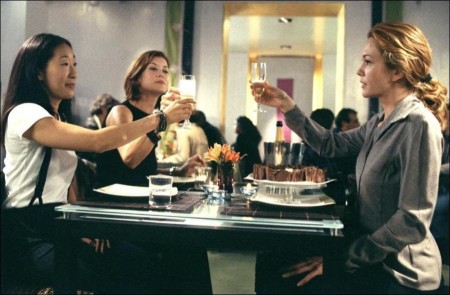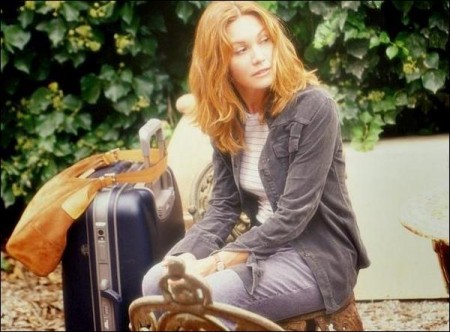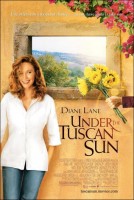In November 1998, Tom Sternberg was producing “The Talented Mr. Ripley” in Italy. It was the penultimate week of the movie’s seventeen-week shooting schedule, and the crew was working in the Tuscan town of Pienza for one day. After finishing the shooting day, Sternberg adjourned to a nearby wine bar with director Anthony Minghella and actor Matt Damon. It was there that fate intervened, resulting in a sequence of events that reflect in many ways the threads of chance and coincidence that characterize Frances Mayes’s own story.
“I noticed a couple picking out wine glasses,” Sternberg recalls. “They were speaking English and we struck up a conversation, only to find out that it was Frances and Ed Mayes.” Sternberg had read – and enjoyed – Mayes’s bestselling memoir a year earlier, and was astounded to meet the author.
An international success, Mayes’s Under the Tuscan Sun sold 2 million copies in the U.S. and spent 126 weeks on the New York Times Bestseller List. It has been translated into 15 different languages, with further translations planned, and also is a bestseller in the U.K., Australia, Italy, France, Spain, Israel and Holland. But while the film producer had enjoyed the engaging memoir of an American poet and literature professor who carved out a new life in the Tuscan hills, he had not considered it for film treatment.
“Under the Tuscan Sun is a memoir – the story of my life in Italy – and there was no big dramatic event in it,” says Frances Mayes. “So when people talked to me about making a film, they wanted there to be a murder in it or something like that. I didn’t want that to happen.”
Less than two years later, in March 2000, Sternberg met the Mayeses again in Los Angeles, where all three were guests of the Tuscan Film Commission. At that point Tom Sternberg reread the book and realized its potential as a film, one that would be a faithful adaptation of Mayes’s memoir.
Sternberg and executive producer Mark Gill gave the book to Audrey Wells (“The Truth About Cats and Dogs,”) and asked to hear her take on how to adapt it for the screen. “Audrey came in and nailed it,” Sternberg recalls. “She invented a story whose characters, though wholly of her own imagination, dramatized both the heart and sensuality which were so much the appeal of the book. Her view was that ‘Under The Tuscan Sun’ should be a lush, classical romantic comedy whose point is that if you stop looking for love, love will find you.”
In June 2001 Wells signed up for “Under The Tuscan Sun” as writer/director and shortly afterwards traveled to Europe with her family. During that time she made a short side-trip to Cortona in Tuscany to meet the Mayeses at Bramasole. “Frances and Ed made us dinner, and I liked them enormously. I found them to have such generous spirits that it was inspiring just to know them.”
The Script
“I wanted to make an ecstatic movie about heartbreak.” (Audrey Wells) Early in 2002,Audrey Wells began drafting her script of “Under The Tuscan Sun.” From the start, she sought to fuse her own aims with those of Mayes’s book, pursuing, as she puts it, “a happy marriage of ideas.”
Wells appreciated that Mayes had written “a very dense and poetic autobiographical tale about buying a Tuscan villa with her husband, restoring it, and becoming immersed in Italian life. Her writing is full of wonderful detail, personal meditations and atmosphere. The only thing her book lacks is the dramatic storyline that works for film.”
Mayes agreed that a successful screen adaptation of her book would entail melding her work with Wells’s ideas, which, however inventive, were entirely at one with the book’s core themes of renewal, of making life an adventure.As it turns out, Mayes is an enthusiastic partisan of what Wells has wrought. “I was astonished to find,” says the author, “that Audrey created a storyline not present in my book, yet one in which I recognize my book, and myself. The film is very harmonious with the underpinnings of what I wrote.”
Here again, a certain serendipity came into play. Recalls Wells: “When I first read the book, I was already in the process of working out an idea in my head for an entirely different script, one about a woman overcoming heartbreak. I realized, with some amazement, that my idea could combine elegantly with the world Frances described.”
One bold structural move Wells makes, as a storyteller, is to leave the blood and guts of the dreaded divorce entirely off screen. We never meet Frances’ husband. Our only glimpse of this man is as a ghostly blur in an old snapshot. What is clear in the photo is Frances’ lost happiness. That was no blur.
For the rest of it, Wells develops this tale of her broken heroine with exuberant lightness and speed. What matters from end to end is Frances, and her new adventure. Everything that went before was another life.
A central experience in Wells’s own life as a movie lover was Federico Fellini’s 1957 Academy Award® winner for Best Foreign Language Film, “Nights of Cabiria.” “When I think of Giulietta Masina in that film, especially near the end – that is one of my favorite moments in all of movies.When she’s been duped by a lover yet again, and this time has lost everything. There she is – destroyed. You think. But then, she picks herself up, dusts herself off, and starts to walk, all alone, down that road through the forest, and even then she finds a way to reconnect with life. She remains open enough to be touched by the sweetness of the young lovers and strolling minstrels who weave by, on foot and on their little motor scooters. You can just see it on her face that she’s renewed, as she looks around, and even looks straight at us. She’s going to live again. She’s even going to fail again! And so what? That, to me, is absolutely transcendent.”
What Wells sees is a hidden harmony between what we suffer, and what we must become. “I think painful things are funny,” she says. “That which hurts is the richest mine for comedy – those things that horrify you most, that scare you most.The road back from personal catastrophe is full of peril. It can be inspiring, a little crazed, and like all painful things, darkly funny. I wanted to look at this journey with attention and humor.
“What the character Frances realizes in her journey,” continues Wells, “is that you have to keep saying yes, despite the chance of failure. Yes to experience, yes to the unexpected, yes to the thing you dread. Frances is not a Candide living ‘in the best of all possible worlds,’ and neither are any of us. But she keeps going.The mere act of refusing to give up yields a tremendous good for her, in the shape of a new life.
“I am interested in the resiliency of the heart,” says Wells, “in how people find a way to recover from emotional disasters. When I wrote the screenplay, I gave every character in the story a broken heart. The worst off, of course, is Frances – whose marriage has collapsed and whose heart and spirit have been shattered. She barely has the courage to face the day. How can she face the rest of her life? That’s her challenge, and her effort to recreate her life and start again is the story of this film.”
Under the Tuscan Sun
Directed by: Audrey Wells
Starring: Diane Lane, Raoul Bova, Sandra Oh, Lindsay Duncan, Dan Bucatinsky, Vince Riotta, Giulia Steigerwalt, Kate Walsh
Screenplay by: Audrey Wells
Production Design by: Stephen McCabe
Cinematography by: Geoffrey Simpson
Film Editing by: Arthur Coburn, Andrew Marcus, Todd E. Miller
Costume Design by: Nicoletta Ercole
Set Decoration by: Nick Evans, Mauro Passi, Cinzia Sleiter, Cynthia Sleiter
Music by: Christophe Beck
MPAA Rating: R for sexual content, language.
Studio: Touchstone Pictures
Release: September 26, 2003



